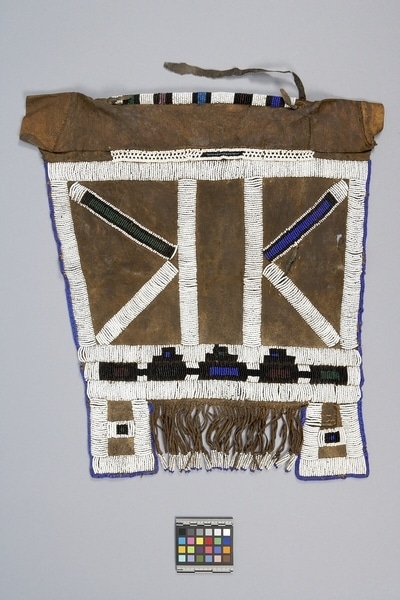Apron Item Number: Ab344 from the MOA: University of British Columbia


Description
Rectangular skin apron. Apron is wider at the top and tapers towards the bottom. Top of apron has a long tubular beaded rim with white, black, green, purple, and blue beads wrapped around a fibre form. Skin flap extends below beaded fibre form. Overall design on skin apron consists of white rectangles, and triangles in white, black, green, and blue, and purple. In between two panels on either side of the bottom of the apron, there is a section of skin fringe with white and blue beads attached to the ends.
History Of Use
Married woman's apron, liphotu; traditionally made on goatskin, but later also on canvas. It is distinguished from the ijogolo by having two side flaps with beaded tassels hanging in a row between them. According to Powell (in ‘Ndebele: a People and their Art): "Informants confirmed that there was an old symbolism operative here, with the side flaps representing the two marriage partners and the tassels the expectation of the children the woman would bear." Also: 'the liphotu is first worn by the bride at the wedding ceremony...the ijogolo with four or five panels, is worn after women have borne children.'
Item History
- Made in South Africa
- Owned by Peter Christie before October 29, 1987
- Received from Peter Christie (Seller) and Museum of Anthropology Shop Volunteers (Funding source) on October 29, 1987
What
Who
- Culture
- Ndebele
- Previous Owner
- Peter Christie
- Received from
- Peter Christie (Seller) and Museum of Anthropology Shop Volunteers (Funding source)
Where
- Holding Institution
- MOA: University of British Columbia
- Made in
- South Africa
When
- Ownership Date
- before October 29, 1987
- Acquisition Date
- on October 29, 1987
Other
- Item Classes
- beadwork; textiles
- Condition
- fair
- Current Location
- Case 102
- Accession Number
- 1235/0004